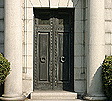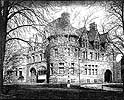|
The text below is an excerpt
from
Buffalo's Delaware Avenue: Mansions
and Families, by Edward T. Dunn. Pub. by Canisius College Press,
2003, pp. 360-362
Frank and Charles Goodyear: Their progenitor was Dr. Jabez Bradley Goodyear,
born in 1816, in Sempronius, New York. He dropped the Jabez at the time of his marriage.
His first occupation was that of tailor. In his mid-twenties, he spent two years
traveling through the South, supporting himself by his trade before returning to
New York where he was induced by his uncle, Dr. Miles Goodyear, president of the
Cortland County, Medical Society, to start practicing medicine as early as 1843.
Jabez graduated from Geneva Medical College in 1845 and married Esther Permelia
Kinne.
She had been born in Cortland in 1822 of New England stock, including an ancestor,
who, in the best tradition of earnest Puritans, had come to America via Leyden, Holland,
in 1635.
They lived in Virgil but moved to a farm near Cortland where there two sons were
born, Charles Waterhouse in 1846 and Frank
Henry in 1849.
Frank Goodyear
Frank was a standard nineteenth century tycoon. Soon
after his birth, his family moved to Holland in Erie County. As a boy he worked at
Root & Keating's tannery as did brother Charles. Frank attended the district
school and East Aurora Academy when his father was practicing medicine there. Later
Frank taught in the district school. He then went to Looneyville in Alden as a bookkeeper
for Robert Looney, a native of the Island of Man, who ran a farm, sawmill, general
store, and feed and grain business and also owned vast timberlands in Pennsylvania.
In 1871 Frank married the boss's daughter, twenty-year old Josephine. Next
year her father died. Frank had already moved to Buffalo where he set up a coal and
lumber business with help from the ubiquitous Elbridge
Spaulding.
Frank had arranged that Josephine's share in her father's estate should be timberlands.
He threw himself into the lumber business, setting up several mills in his timberlands
along the Western New York & Pennsylvania to Buffalo.
In 1884 he bought more land in Potter County and built a sawmill at a town he
renamed Austin, which became headquarters of his empire. He initiated temporary railroads,
called tramways, to carry logs to his mills instead of floating them down on streams.
His frantic pace brought on a nervous breakdown, during which he induced Charles
to form E H. & C. W Goodyear and took a European rest cure. The story of their
joint activities is that of two brothers who did not get along.
The Achilles heel of the Goodyear empire was Frank's decision to expand the railroads
servicing his sawmills into an interstate road, the Buffalo & Susquehanna, to
link his mills and the coal mines in western Pennsylvania with the Buffalo
&Susquehanna Iron Company which the Goodyears had formed in 1902 to operate
blast furnaces south of Buffalo on Lake Erie. Two freighters, the Frank H. Goodyear
and the S. M. Clement, were built to carry ore from the company's mines in
Minnesota and Michigan down to Buffalo. This was vertical integration, but it duplicated
existing services with an inefficient railroad:
In 1906 the Goodyears built the Buffalo & Susquehanna Railroad from Wellsville
to Buffalo, nearly 90 miles. A year later Frank Goodyear died; his brother Charles
died in 1911, and the Goodyear empire began to fall apart. The expense of constructing
the line to Buffalo began to cause financial difficulty, and the road laid aside
plans to extend its line to Pittsburgh and relocate its line to eliminate the four
switchbacks over the mountains between Galeton and Wharton. The Buffalo & Susquehanna
Railway leased the Buffalo & Susquehanna Railroad, but that didn't forestall
receivership. After a brief period of operation as the Wellsville & Buffalo,
the Buffalo extension was scrapped in 1916.
More successful were Frank's ventures in Louisiana where in 1901 he acquired a
large tract of white pine. Next year the Great Southern Lumber Company was formed
with Frank as president and Charles vice-president. They had invested $9 million
in 300,000 acres in Louisiana and Mississippialong the Pearl River. In 1905 a town
site was selected along the Bogue Lusa Creek, a tributary of the Pearl, and a town
christened Bogalusa was built with shops, offices, a bank, and separate black and
white residential sections, all centered on a sawmill. The ninety mile New Orleans
Great Northern Railroad was created to connect Bogalusa with the national network.
Frank died of Bright's disease in 1907, shortly after moving into his new home
at #672 Delaware. He had not gotten much physical exercise and though only five feet
eight, he weighed 220 pounds, a victim of overeating. His absorbing interest was
business and he had a keen business sense. His estate was worth $10,000,000. The
family chronicler wrote:
He had a quick, eager, incisive mind and was irascibly impatient with the plodder
... He was forever making notes and even at a formal dinner there was a pad and pencil
beside his place. Often he could not read the notes he had made ... He was never
really happy. The only thing he enjoyed was success that needed constant increase
and he died looking failure in the face, the failure of his pet project, the Buffalo
and Susquehanna Railway. He was the head of every enterprise with which he was connected,
all of them, but the one, greatly successful. He told me that if a man was successful
in six out of ten enterprises he was himself a success and seven out of ten made
him an extraordinary success, but when it came to his own case he needed ten out
of ten.
Shortly after his death the panic of 1907 struck. Town and railroad building stopped.
The sawmill had been completed, but did not go into operation until late 1908. But
though the effects panic lingered, the decision to start up proved sound. It was
the largest sawmill in the world.
Frank's money-making left him little time for other activities. President
Cleveland appointed him in 1886 to examine federal land granted to the Northern
Pacific Railroad. He was Park Commissioner of Buffalo, president of the Buffalo Club
in 1903, and director of three local concerns: Marine Bank, Rogers Brown Iron Company,
and United States Leather, a customer for the bark from his sawmills. His clubs were
the Lawyers' and Manhattan clubs of New York, the Buffalo, Country, Ellicott, Falconwood, and Liberal clubs of Buffalo,
and the Jekyll Club of Jekyll Island, Georgia.
762 Delaware
Frank's mansion at 762 Delaware, modeled on a house
on the Champs-Elysees in Paris, was completed in 1906. By then his three daughters,
Grace who married Ganson Depew, Josephine who married George M. Sicard, and Florence
who married George 0. Wagner, had left home.
Frank had resided briefly at #443 Delaware when he came
to Buffalo in 1872. Thereafter he lived in succession at #652 Main [across the street
from the Pierce Building],
#671 Main [across the street from the Greyhound
Bus Terminal], and #267
North, the Bemis House.
Family
His wife Josephine, a retiring soul, died at sixty-four in October 1915
of the effects of a heart attack at the Exchange Street Station. She was remembered
as the benefactress of the convalescent home for children named after her in Williamsville.
Grace, the eldest of Frank and Josephine's children, had been born in 1872.
In 1894 she married Ganson Depew who had been born in 1862 and was everybody's choice
for Mr. Nice Guy. He was the nephew of Chauncey Depew, president of the New York
Central and Senator from New York 1900-1911. Admitted to the bar in 1887, Ganson
deserted the law to work for his father-in-law and became manager of Goodyear Lumber,
vice-president of Buffalo & Susquehanna Coal, and assistant to the president
of the Buffalo & Susquehanna Railway.
Frank Goodyear's second daughter, Josephine, born in 1874, married George
Montgomery Sicard in 1900. The Sicards came from Utica where George was born
in 1872. His uncle, George J. Sicard, was a partner of Cleveland, Bissell & Sicard,
and later of Frank's brother Charles in Bissell, Sicard & Goodyear. George Sicard
attended Utica Academy, graduated from Yale in 1894, received his law degree from
N.Y.U. in 1895, and came to Buffalo where he began practice with Moot, Sprague &
Brownell. After marriage he went to work for Frank's lumber and railroad companies.
Josephine, his wife, died 1904. Soon afterwards Sicard, who had not gotten along
with his father-in-law, resigned from his companies and moved to Pelham Manor where
he lived the last thirty years of his life.
Florence, Frank Goodyear's third daughter, attended Saint Margaret's School
in Buffalo and finishing school in New York. Back in Buffalo she married in 1902
George Olds Wagner ....
Frank H. Goodyear, Jr., was born in Buffalo in 1891. He married Dorothy
Knox, the daughter of Seymour and Grace
Knox.
|
![]()














